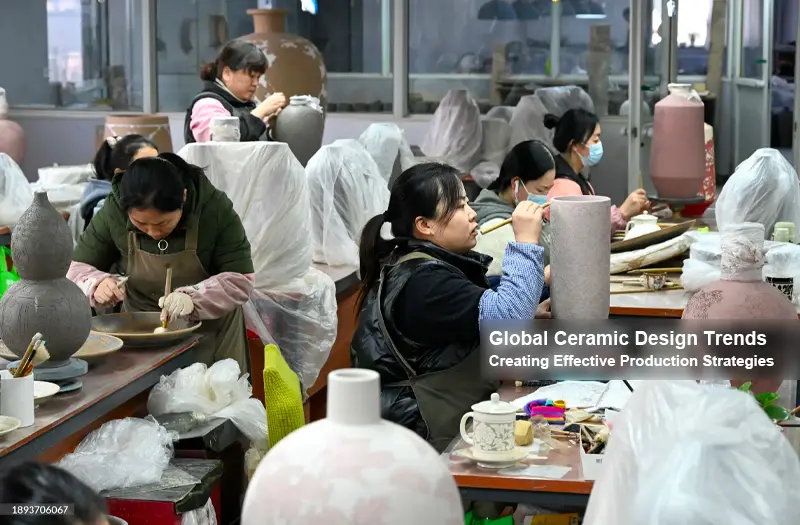
A cerâmica não é apenas um artesanato tradicional, é também um símbolo da cultura, da história e do estilo de vida moderno. Como fabricante de máquinas para cerâmica Com muitos anos de experiência, estamos bem cientes da importância do design de cerâmica no mercado global. A fim de ajudar os nossos clientes a compreender melhor e a entender a tendência global do design de cerâmica, planeamos lançar uma série de artigos especiais sobre design de cerâmica. Através destes artigos, iremos explorar em profundidade os estilos de design de cerâmica em diferentes regiões e como satisfazer as necessidades do mercado em mudança, optimizando a tecnologia de maquinaria para cerâmica. Esperamos que estas ideias possam fornecer referências valiosas aos fabricantes de cerâmica e ajudá-los a destacarem-se no mercado global.
A importância e a diversidade da cerâmica na vida global
Os produtos cerâmicos ocupam uma posição importante na vida global. Não são apenas necessidades da vida quotidiana, mas também decorações, bens comerciais e até indispensáveis no domínio da alta tecnologia. Enquanto símbolo cultural, a cerâmica possui ricas conotações históricas e artísticas. Especialmente na China, a cerâmica é o representante da quintessência nacional. No entanto, os estilos de design de cerâmica em todo o mundo também são ricos e coloridos, cada um com as suas caraterísticas. Diferentes contextos culturais e históricos dotaram a cerâmica de elementos de design únicos, fazendo com que apresentasse um encanto único na forma e no padrão. É este design diversificado que tornou a cerâmica única no mercado global.
A influência do design no comércio da cerâmica
Nas nossas trocas comerciais com países nacionais e estrangeiros, sentimos profundamente as diferenças nas exigências de design de cerâmica em diferentes mercados. A resposta do mercado pode comprovar o sucesso do design e os clientes estão constantemente a procurar novos designs. Como grande produtor de produtos cerâmicos na China, as nossas ideias gerais de design continuam a ser executadas de acordo com as nossas ideias, que por vezes não são tão boas como o design e a produção locais. Embora a maioria dos nossos fabricantes de cerâmica se diferencie de acordo com as preferências dos clientes em diferentes países e regiões, o design geral ainda precisa de satisfazer com mais precisão as necessidades do mercado-alvo. Se conseguirmos compreender e entender estas diferenças subtis, isso ajudará a aumentar a competitividade dos produtos cerâmicos no mercado internacional.
Conhecimento profundo das tendências mundiais de design de cerâmica
Este artigo examinará as ideias gerais de design e os antecedentes da cerâmica em todo o mundo para ajudar os fabricantes de cerâmica a desenvolver melhor os produtos e a explorar a forma como máquinas de cerâmica pode ser melhorado para apoiar estes objectivos de conceção. Ao aprofundar o nosso conhecimento das diferentes regiões, podemos responder melhor às necessidades dos clientes no comércio internacional.
Elementos comuns no design de cerâmica
Existem muitas variedades e padrões de cerâmica, pelo que uma nova cerâmica tem de prestar atenção a muitos factores ao desenhar. O equilíbrio geral e a forma são padrão? As curvas e a simetria são simétricas? As cores do vidrado e os padrões são bonitos? E o simbolismo e o significado que lhe estão subjacentes? Estes factores são sobrepostos, juntamente com a influência da cultura regional e das tradições históricas, e são concebidas várias formas e cores de cerâmica.
Embora existam tantos factores que afectam o design da cerâmica, de facto, para além da expressão artística, a maioria das ideias de design são rastreáveis, tais como figuras, flores e pássaros, textos, cenários sazonais, mitologia e religião, figuras geométricas, que são factores comuns no design da cerâmica. Por vezes, aparecem sozinhas, outras vezes estão dispostas e combinadas. Após a combinação de linhas e esmaltes coloridos, através de uma cozedura razoável e moderada, nascem peças de cerâmica cristalinas e bonitas.
Análise dos estilos de design cerâmico em regiões típicas
Especificamente, tomando a China como exemplo, as cerâmicas utilizadas na vida quotidiana são maioritariamente decoradas com padrões como flores e pássaros, galos e paisagens, e vasos. Os pratos de cerâmica são sobretudo decorados com padrões como paisagens, dragões e fénix, textos e alusões. O estilo geral é também fresco e elegante, e a pintura chinesa e a pintura a tinta são utilizadas para o representar, sendo deixados muitos espaços em branco. As regiões árabes e indianas preferem o dourado, com padrões de figuras mitológicas, actos e símbolos das crenças muçulmanas e indianas como cores principais. Para além do dourado, são utilizadas várias cores para apresentar um efeito colorido, que é extremamente impactante do ponto de vista visual. Além disso, a Europa, os Estados Unidos, o Japão e outros locais também tentaram integrar os seus estilos artísticos no design de cerâmica. Por conseguinte, o design de cerâmica tem apresentado um cenário de todas as coisas que competem a nível mundial.
Direção do desenvolvimento futuro do comércio de cerâmica
Na atual situação económica global, as relações comerciais entre países tornaram-se tensas e muitos países começaram a procurar a produção local de cerâmica. Como se adaptar à situação atual e explorar novas direcções para o comércio externo de cerâmica é um tópico comum para os nossos fabricantes nacionais de cerâmica. Em conjunto com as ideias de design de cerâmica acima descritas, continuarei a investigar os estilos de cerâmica de diferentes países e regiões. Se conseguirmos compreender as ideias de design orientadas para o mercado, os nossos fabricantes de cerâmica atingirão um nível mais elevado no comércio externo de cerâmica.
Conclusão
A cerâmica não é apenas um meio para comunicarmos com o mundo, mas também uma forma importante de compreendermos e nos integrarmos na cultura global. Através da otimização contínua do design e da melhoria do processo de produção, espera-se que alcancemos maiores realizações no comércio internacional de cerâmica e criemos maior valor para a sociedade e para o país. Continue a prestar atenção ao nosso sítio Web oficial https://yutaimachinery.com para lhe trazer as últimas informações sobre o sector da cerâmica e guia profissional para máquinas de cerâmica.
